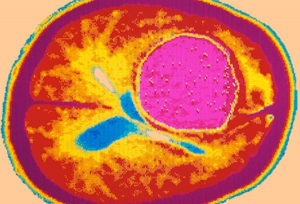A group from the National Institute of Neurological Disorders and Stroke, NIH, has reported finding Epstein-Barr Virus (EBV) and HHV-6 but no cytomegalovirus (CMV) in astrocytomas, a brain tumor comprising approximately one quarter of all gliomas diagnosed. The group used digital droplet PCR (ddPCR), a technique that is highly precise but less sensitive than nested PCR and immunohistochemistry, techniques that have been used in previous studies.

Positive samples for tumor samples and control tissues, by virus.
The investigators studied 112 tissue specimens, made up of 45 glioblastoma samples, 12 astrocytoma grade III, 2 astrocytoma grade II, 4 astrocytoma grade I, and 49 control specimens, and compared the viral load in the tumors to that in adjacent tissues and control samples.
HHV-6B was found in 8 tumor samples and was the most frequently detected virus but was also found at low levels in two controls. Control tissues included patients who had atherosclerosis, myocarditis, pneumonia or other non-neurological conditions.
Finding appropriate controls is a challenge for HHV-6 studies because latent HHV-6 is found at low levels in brain tissues, and because HHV-6 reactivates in a large number of conditions including cardiomyopathy and atherosclerosis ( Kuhl 2005, Magnoni 2012).
Viral loads of HHV-6B ranged from 100 to > 20,000 copies/million cells. EBV was not detected in any controls, but viral loads in tumors ranged from <1,000 copies to >17,000 copies per million cells. Statistical analysis determined that the association with EBV was significant, (p=0.049) but that the association with HHV-6B was not significant (p=0.147) because 2/49 controls were also positive.
Grade IV astrocytomas, or glioblastomas, have a median survival time of 12 months and an average 5-year survival rate of 5%. However, a report in the New England Journal of Medicine reported that 40 glioblastoma patients treated with 6 months of valganciclovir lived much longer, an average of 56.4 months (Soderberg-Naucler 2013).
The role of herpesviruses in gliomas is controversial, and attention in recent years has focused on CMV. A Chinese study using a sensitive technique, nested PCR, found 17/40 samples positive for HHV-6, and HHV-6A was cultured from a glioma cyst. They also found EBV, HSV1, HHV-7, and CMV (Chi 2012). A recent paper using a bioinformatics system called VirusScan found that human papillomavirus was the most common virus found in the brain, and HHV-6 was the most prevalent herpesvirus (Cao 2016).
For more information, see the full paper, Lin 2016.

